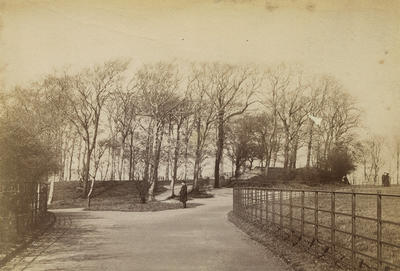
Trees growing on the earthwork on Camp Hill in Queen's Park, photographed by Duncan Brown c 1890s. Brown (1819-1897) was a talented amateur photographer whose work documented aspects of Glasgow life from the 1850s until the 1890s.
The photograph shows the earthwork (possibly Iron Age, 700 BC - 500 AD) from which Camp Hill took its name. The earthwork consists of a roughly circular bank of earth surrounded by a ditch and may have been part of a larger fortification covering the entire hilltop. Inside the earthwork are faint traces of rig and furrow, indicating that the area was used as farmland in the medieval period. The trees were planted later to provide a shelter belt for Camphill House and its policies.
In 1867 the Glasgow Herald reported that the Thompson family of Camphill had employed workmen to excavate near the centre of the earthwork. The men found the remains of a paved floor plus charred oats and pieces of oak at a depth of about 8 feet. It was assumed that the structure had been a kiln for drying grain.
Reference: 44
Reproduced with the permission of Glasgow School of Art Archive
Keywords:
archaeology, Camp Hill, Camphill Earthwork, earthworks, excavations, fortifications, hill forts, Iron Age, kilns, oats, parks, Queen's Park, trees
You have 0 images in your photo album.